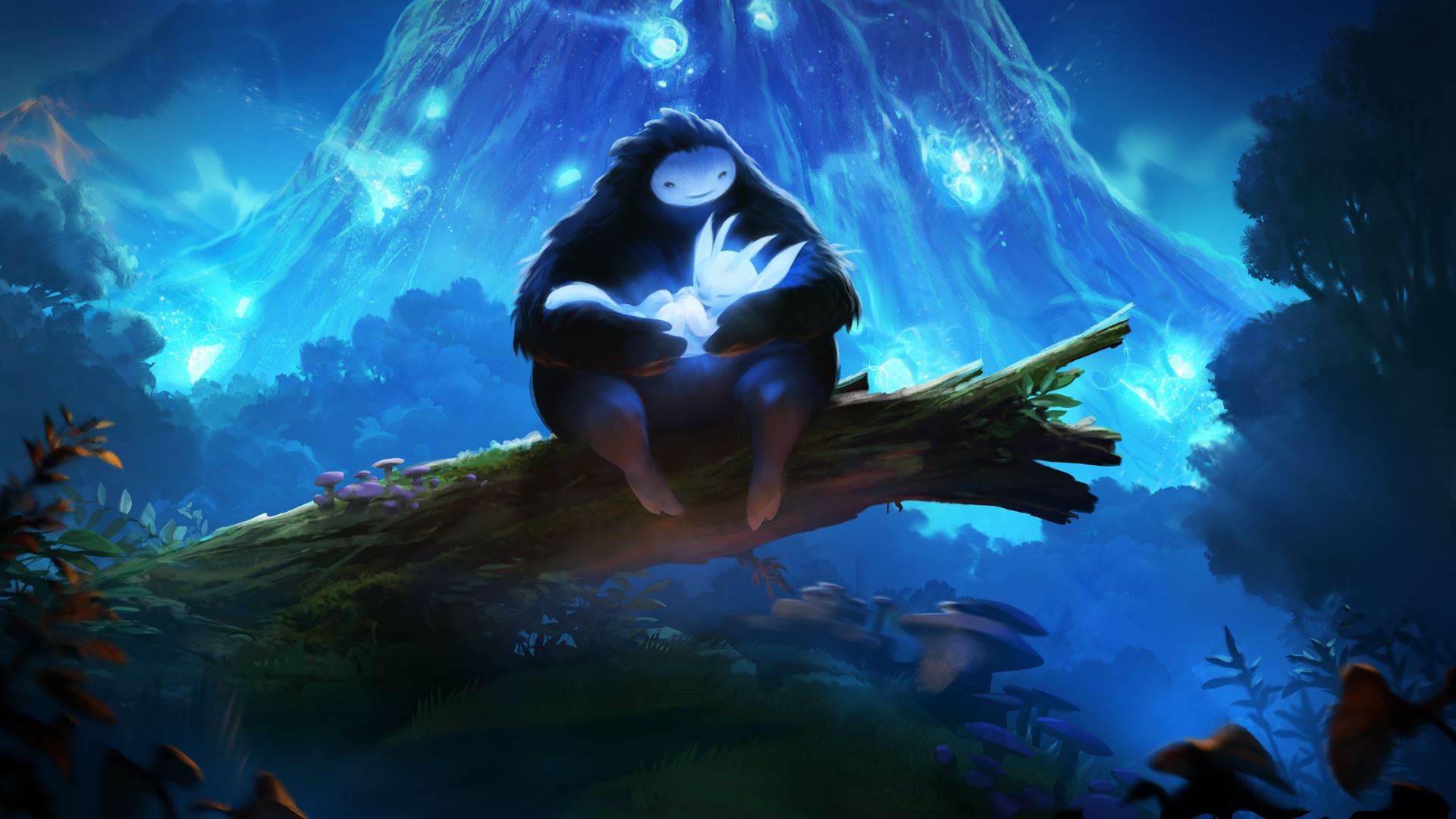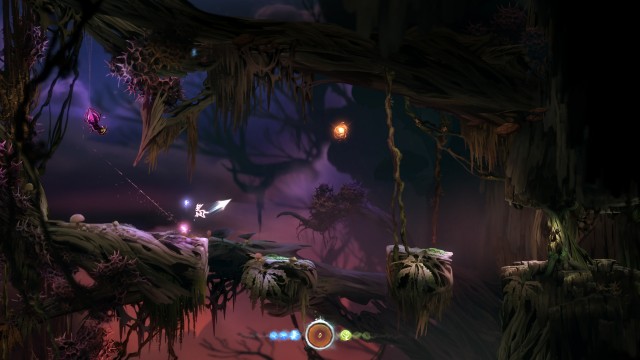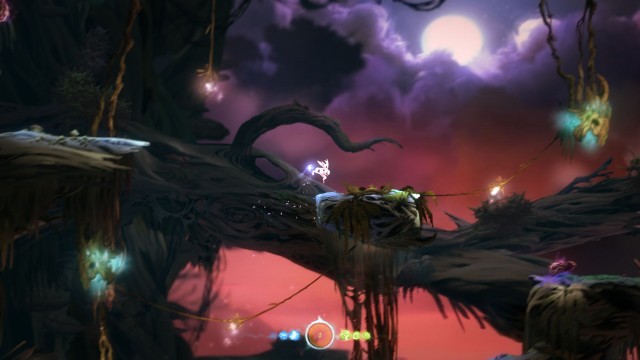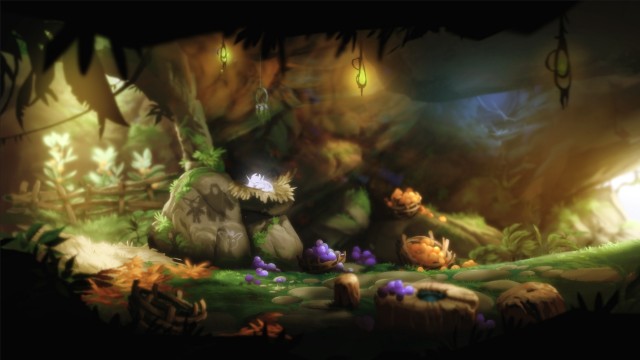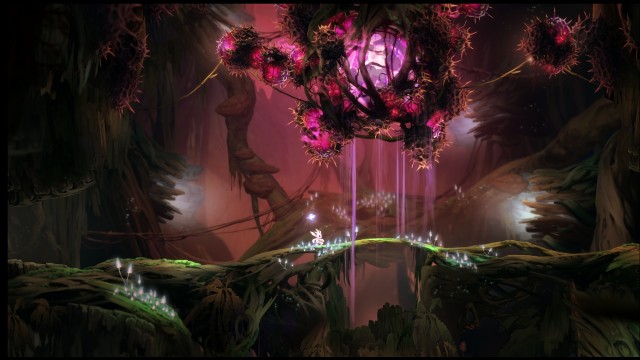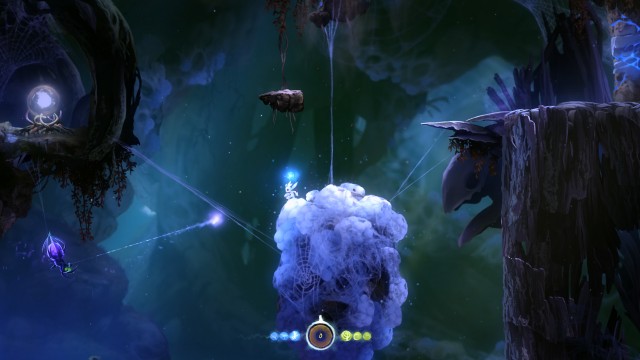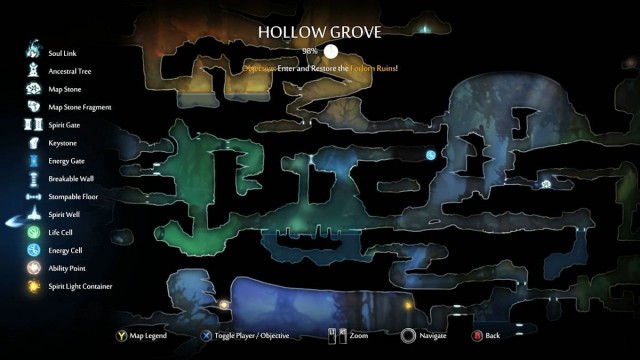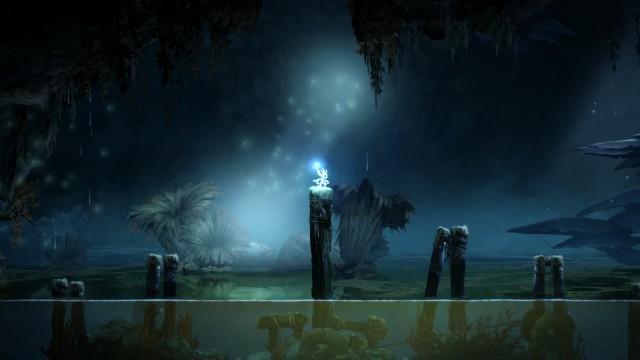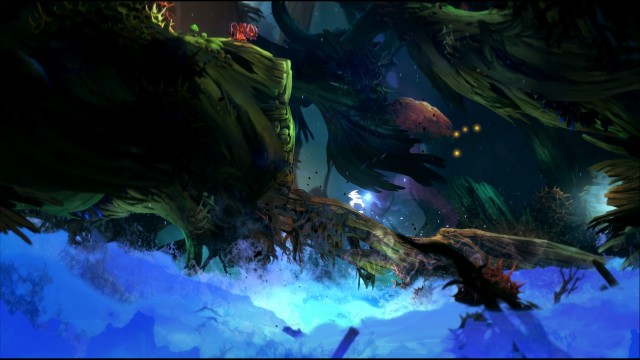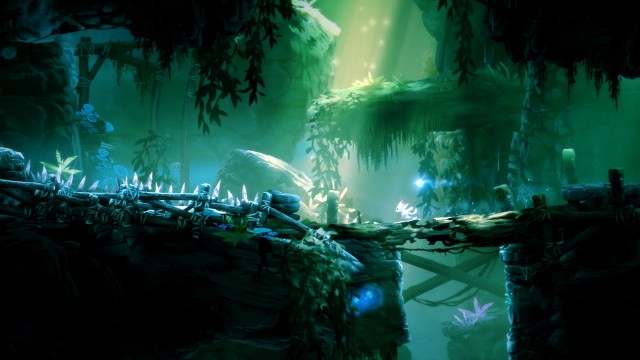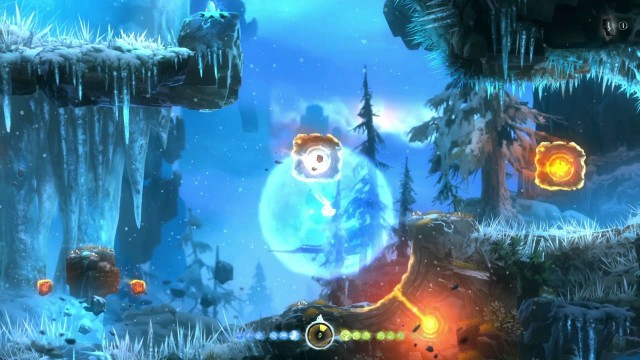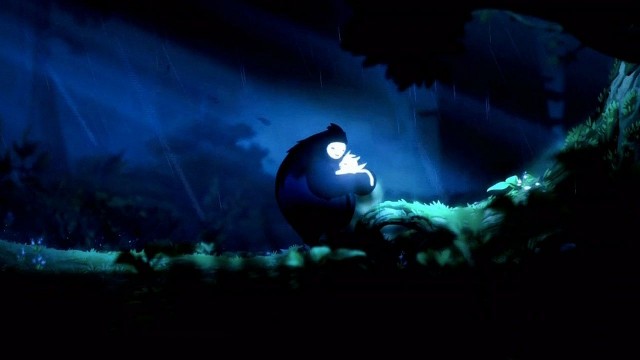Ori and the Blind Forest is a thing of deceptive beauty. It’s one of those games that lures you in with its adorable presentation and gorgeous, expansive world. It’s also one of those games that will make you feel the pain of said world’s plight, with only avid, patient gamers having a shot at seeing the end of its gauntlet of hazards and fiends.
Ori and the Blind Forest comes to us as the first official game release of independent developer, Moon Studios, put together in collaboration with Microsoft. As a result of Microsoft backing the project, the game is only available for Windows PC’s and Xbox One, with an Xbox 360 port being expected some time later this year. It’s also one of the best independent game projects that the Xbox platform most notably has seen in quite some time, even though PC gamers will still be getting a very high-quality adventure here, if they can handle the challenge, that is.
There’s plenty to enjoy about Ori and the Blind Forest beyond its gameplay, between its breathtaking graphics, calming audio suite, and pervasive sense of charm, but the occasional frustrations do sometimes disturb its potent beauty, even for those skilled enough to play it. Some of the area design is suspect, not to mention the fact that you can’t continue to explore any remnants of the world that you missed upon completing the game, which is a downright baffling design decision. Lastly, Xbox One players will be in for a slightly bumpier ride, due to a few unique glitches and technical issues that aren’t present on PC.
Still, Ori and the Blind Forest is a breathtaking experience on both of its platforms, putting players to the test, but rewarding them with the chance to save a world that is truly a wonderful place to be in.
Ori and the Blind Forest is a truly beautiful game. It unfolds in a lush and highly atmospheric stretch of woodlands, one that will take players across a nicely varied set of otherworldly environments, in their quest to bring light back to the world.
The game performs incredibly smoothly, with a brisk 60fps framerate that never dips below maximized performance on either platform. This is handy in the late game especially, where there’s a lot of emphasis on using your reflexes and chaining together abilities to navigate especially tricky hazards. Both the combat and the exploration can often unfold in a blistering, almost overwhelming fashion, but the way that the game never chugs amidst all of this chaos is highly impressive. Even more impressive is that load times are pretty well non-existent, beyond the initial boot-up.
You can potentially boost the high graphical fidelity to even more incredible new heights on PC, though Xbox One players can still enjoy a lovely adventure at native 1080p resolution. Ori and the Blind Forest is without question one of the most beautiful indie games available on Xbox One, even giving several full retail offerings a run for their money, thanks to its highly detailed and emotionally stirring art style. PC players had best be advised that they’ll at least need Windows 7 to even start the game, along with at least a higher mid-range graphics card, but high-end gaming rigs that can truly crank the settings will give the PC version of Ori and the Blind Forest a slight added visual edge over its Xbox One sibling.
Another slight knock against the Xbox One version of Ori and the Blind Forest is that it seems to be less stable than the PC version. While a good chunk of the potential game-breaking bugs that seemed to exclusively rear their ugly heads on Xbox One have since been patched out by Moon Studios, the Xbox One version of Ori and the Blind Forest still seems to occasionally crash on startup, and on rare instances, it will also crash at random during gameplay, kicking you back to the Xbox One dashboard, potentially with an annoying loss of progress. It’s not that common, but it is very annoying, and suggests that Ori and the Blind Forest is first and foremost designed for PC.
Regardless though, Ori and the Blind Forest almost unfolds as a Western interpretation of a Studio Ghibli movie, or perhaps a video game take on something that animators like Don Bluth used to deliver with movies like The Secret of NIMH. Its animation is striking and impactful, telling the story even more than the small snippets of gibberish dialogue do. Players will be motivated to save this world because they will quickly fall in love with its beauty, and that can be a far better incentive than yet another wise man telling you that you’re chosen by the gods, so you’d better get to it.
Ori and the Blind Forest envelopes you with ethereal, compelling charm right from startup, as its gentle, melodic music helps to create a sense of quiet reverence for what you’re about to experience. The soft piano chords headline a subtle, but evocative orchestral score, inviting you into a world of mystery, but also one of sadness and regret.
Similarly, the audio feels understated, yet in a very effective way. Occasional sharp sounds like cries of pain from Ori, or the surges of sidekick, Sein’s protective flame attack, will punctuate the gentle footsteps and determined leaps of your main character, with the sounds intensifying as the game goes on, following the environment getting gradually more and more hostile. Those with top-of-the-line sound systems can best take advantage of Ori and the Blind Forest’s incredible audio work, which will have the game leaping to life and appearing to engulf the room, as you stumble around misty forests, leap along poisonous swamps, and trek through dark, treacherous tunnels, among many other things.
There isn’t really voice acting to speak of in Ori and the Blind Forest, though some fictional gibberish talk will sometimes play in the background over the text boxes, similar to games like Banjo-Kazooie or Rayman 2: The Great Escape. It helps to create a great sense of wonder, better than just reading out the dialogue in English would, particularly since Ori is a silent protagonist anyway, if you don’t count his occasional yelps when he’s hit.
Ori and the Blind Forest boasts audio that’s just as breathtaking as its visuals, contributing all the more to a world that you’ll get lost in, and never want to leave, without discovering every secret it has to offer.
Ori and the Blind Forest is a ‘Metroidvania’ game, being an open-ended 2D platformer adventure that entirely unfolds in one single, persistent location. In this case, said location is the titular ‘Blind Forest’, which has had the light stolen from it by a mysterious monster, in turn extinguishing the benevolent influence of the guardian Spirit Tree.
Our lead character, Ori, a small, orphaned creature who loses his adoptive mother, Naru to the extinguishing of the light, is thus left to fend for himself, and players must guide him through the darkened, hazardous forest. Thankfully however, Ori is not alone, since he’s protected by a small light spirit called Sein, who requires his help to restore the three elements of the forest.
The object of the game then is to reach the hiding places of the three extinguished elements, and restore them to life. This involves exploring wherever you can in the open setting, defeating monsters, building up EXP, and naturally, finding new abilities for Ori, which will allow him to access new locations. If you’ve played a Metroidvania game before, Ori and the Blind Forest strikes those familiar beats.
Despite its charming appearance though, Ori and the Blind Forest doesn’t make any concessions for the player. When you get a new ability, the button/key prompts are shown for it, but learning how to master it is up to the player. Likewise, while the game points you to key locations where you can proceed the story on the in-game map, it doesn’t tell you how to get there. Ori and the Blind Forest gives you just enough feedback to get a sense of direction, but it certainly doesn’t hold your hand. Mastering the game has to be done on your own wits and skills.
For the most part, the varied and interesting environments of Ori and the Blind Forest are also a joy to explore. The handful of puzzles are inspired, and the combat encounters feel engaging and interesting, especially as Ori gets more abilities later in the game. Even Ori’s basic attack, the Spirit Flame, requires a bit of time to adequately master, since its range and direction is very particular, and you certainly can’t just run up to enemies and mash a button/key to get rid of them, without incident. Ori does eventually gain more offensive abilities, which consume his Energy Meter (both this and Ori’s health can be extended by finding Life Cells and Energy Cells hidden throughout the game world), but even then, calculating range and defensive maneuvers is a core part of combat. Even weaker enemies can overwhelm Ori in a hurry if you’re careless, with each well-designed enemy demanding its own unique strategy to eliminate. It constantly keeps players on their toes, in a great way!
It’s just too bad then that some of the area design doesn’t keep pace. Most of the environments are very well-done, but a few of them rely a bit too much on loading everything with hazardous spikes. Pair that with some of the collision detection occasionally being finicky when dealing with spikes especially, and you have a few sections that feel more frustrating than rewarding.
Fortunately, if you don’t get lazy with collecting Energy Cells, Ori can use a bit of Energy to create checkpoints, called Soul Links, at the touch of a button/key wherever the player chooses. This is a very interesting and clever system, allowing players to potentially conserve Energy at the cost of not having as much of a safety net if they die, or saving their progress more often, but at the cost of potentially being left without precious Energy to protect them from foes later. This system comes into play a lot more in the early game, where Ori is weaker and doesn’t have as much Energy to spare, but it’s a neat risk/reward mechanic that helps players decide exactly how much they trust their abilities.
Along these same lines is the fact that Ori can only upgrade himself upon gaining enough EXP to get an Ability Point, within said Soul Links. This also encourages you to pick your moments to make a Soul Link, since Ori’s upgrades are pretty valuable, being divided into three branches, one emphasizing efficiency of resources, another emphasizing maximization of abilities, and the remaining one emphasizing combat skills. It is possible to max out Ori on all three branches, and there is in fact an achievement to earn by doing so, but this requires a lot of grinding. Thus, not only do you have to create a Soul Link to even look at Ori’s upgrade tree, but you need to decide which of those three disciplines is most important to you as well, altering your gameplay experience in some pretty significant ways, depending on what you decide.
As I said, getting good with abilities is paramount as well. Later sections of the game are designed to force you to master multiple abilities that you can pull out on a whim, particularly during the especially tense and difficult escape sequences that come up every so often. These uncompromising sections will kick you back to their starts if you screw up even once in most cases, really cracking the whip at players, and not allowing them to slack when it comes to mastering Ori’s full arsenal of capabilities. These segments, among others that force you to make use of multiple abilities at once, are well designed and nicely hair-raising, though the complete lack of checkpoints in most of the longer ones can be an annoying issue.
The chaining of abilities is also the main reason why PC players absolutely must bring a gamepad, if they don’t want to wreck their wrists and/or their keyboards. Ori and the Blind Forest is a rather interesting beast, since it seems to be primarily designed to run on PC, yet the play mechanics are all blatantly designed around an Xbox controller. Playing the PC version with an Xbox 360 controller feels ideal, though the Xbox One controller still works plenty well if you go for that option, or are limited to that option anyway on account of playing the Xbox One version of the game.
Ori and the Blind Forest will probably take you around the neighbourhood of 7-8 hours to complete on your first playthrough, and it’s annoying that the game seals off your file when you beat it, forcing you to start a new game if you want to get another shot at going after what you missed. Fortunately, there’s plenty of replay value for completionists and achievement hunters especially. You’ll have to play and replay Ori and the Blind Forest several times to score every achievement, and that’s after the ones that demand you locate all of the game’s many secrets and bonuses, and explore every last nook and cranny of the map. This gives players eager to test their skills plenty of interesting challenges to strive for, including beating the game without dying, beating the game in under three hours, or beating the game without using a single Ability Point, among other things.
Given how finely crafted and inviting the adventure of Ori and the Blind Forest is, the game demands replays even on that basis alone. It’s the kind of challenging, yet rewarding adventure that avid gamers with a taste for Metroidvania won’t simply want to experience once. Mastery of Ori and the Blind Forest is very hard won, and even just completing the game normally will take quite a lot of skill, given its high difficulty. This is the kind of game that makes you earn your victory, and if you truly deserve its finest accolades, you’re bound to keep at it for even more rewards after said victory too!
Ori and the Blind Forest tells an outwardly simple story, one that only has a handful of dialogue, and proceeds on a mostly straightforward track. Nonetheless, the story is brought to life exceptionally by the animation and scenery, almost making Ori and the Blind Forest unfold as a fantastic video game version of a short story or a poem, one that also happens to borrow plenty of high points from outstanding animated movies.
The whole story simply involves the lost little creature, Ori getting swept up in the grand quest of restoring the forest he’s been orphaned in, but the game’s journey, however simple its story material is, feels incredibly rewarding. The final turnout of the game is nicely heartwarming, and even the villains aren’t necessarily what they seem.
As I said, the driving force behind Ori and the Blind Forest is its visuals, which effectively allow players to fill in the blanks about this world’s lore and history. The actual plight of the Spirit Tree and the Blind Forest may not be complex, but the game nonetheless invites scads of imagination on the part of its players, emotionally engaging them with sublimely directed cutscenes, which almost never rely on dialogue. It’s a very ambitious and unique form of storytelling that serves the video game medium very well, especially for the reduced scale of an independent $19.99 game.
Ori and the Blind Forest’s handful of design frustrations just barely hold it back from being an instant indie classic, but it’s still one of the champion indie game offerings that’s exclusive to the Microsoft catalogue. The game is as breathtaking as it is challenging, with the uncompromising gameplay coming together amidst a world that players will genuinely want to save, simply because it’s been realized so incredibly well.
If you have a Windows-enabled gaming PC with Windows 7 or up that can handle such a visually ambitious game, along with an Xbox controller to plug in and use as a gamepad, Ori and the Blind Forest does feel best experienced on a Windows PC, where it’s at its prettiest and most stable. The Xbox One version is still great, though its shakier stability and small handful of lingering bugs do make it fall a bit beneath the quality of the PC version. It’s still well worth experiencing if you own an Xbox One, and you don’t have the option of playing the PC version though, even if you’ll need to have a tad more patience towards the abrupt crashes that occur every so often on Microsoft’s console.
Microsoft has lately been considerably lagging behind Sony, Valve and Nintendo when it comes to delivering a steady stream of strong indie games at the rate that those three companies do on their digital storefronts, but Ori and the Blind Forest helps to pick up some of that slack. The Xbox catalogue definitely needs more great indie exclusives like this to call its own, and hopefully Ori and the Blind Forest leads the charge for a new wave of commitment by Microsoft to realizing more games like it on their platforms.

